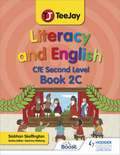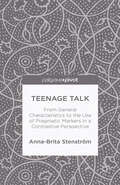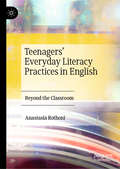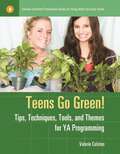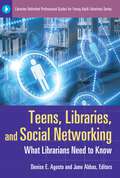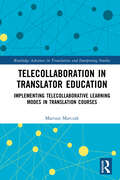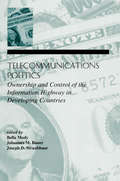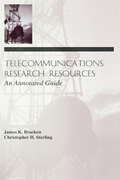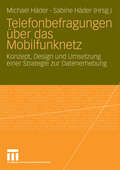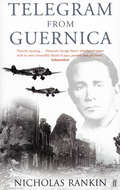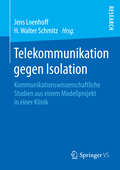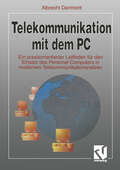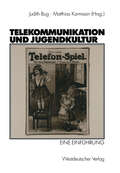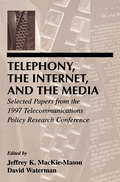- Table View
- List View
TeeJay Literacy and English CfE Second Level Book 2C
by Siobhan SkeffingtonAdd fun to your lessons with the only Literacy and English textbooks offering comprehensive, consistent coverage of the whole CfE Second Level curriculum.This brand-new series from TeeJay will enable you to confidently cover all CfE Benchmarks and Experiences and Outcomes for Writing, Listening & Talking, and Reading for Understanding.- Explore different genres and foster a love of reading with exciting text extracts- Bring the fun of learning to your classroom with activities for play-based learning- Help students of all abilities progress at their own pace with tasks for differentiation flagged throughout- Continuously build and consolidate knowledge and monitor progression with end-of-chapter 'Review Revisit, Revise' exercises- Brush up on past teaching with the exercises in Chapter 0, which revise key skills from the previous book- Trust the core TeeJay philosophy - progression and consolidation - to help students build and develop their skills and understanding
TeeJay Literacy and English CfE Second Level Teaching Guide 2B
by Siobhan Skeffington Madeleine BarnesEasily plan and deliver outstanding lessons that are bespoke to your classroom needs.Save time by following step-by-step guidance from experienced English teachers, covering all CfE Experiences and Outcomes and all benchmarks for Second Level Literacy and English.- Prepare with ease: topic overviews at the beginning of each chapter let you know at a glance what to teach and how to teach it, with a summary of key learning objectives, core vocabulary and any barriers to learning- Teach with confidence whatever your level of expertise: follow a structured, ready-made course with each lesson focusing on one key aspect of the curriculum, providing suggestions for best practice- Engage the whole class: comprehensive guidance takes you through a five-part structure for each lesson, with lots of prompts for getting students actively involved in their learning- Easily adjust activities to your classroom needs: additional suggestions for differentiation included throughout so you can support students of all ability levels- Bring the joy of reading to your classroom: foster a love of reading with a pedagogy that centres on exciting texts
Teenage Talk: From General Characteristics to the Use of Pragmatic Markers in a Contrastive Perspective
by A. StenströmThis in-depth study of the use of pragmatic markers by Spanish and English teenagers offers insight into the currently under-investigated area of teenage talk through the analysis of the Corpus Oral de Lenguaje Adolescente de Madrid and The Bergen Corpus of London Teenage Talk.
Teenagers’ Everyday Literacy Practices in English: Beyond the Classroom
by Anastasia RothoniThis book examines everyday literacy in English as a foreign language (EFL). Focusing on the out-of-school literacy practices of teenagers in Athens, Greece, it challenges the notion that classrooms are the only contexts which provide exposure to English for learners. The author demonstrates that English can be a powerful resource for teenagers, as a symbolic tool granting them additional means of communication and self-expression. In doing so, she makes an original contribution to the areas of literacy, language education, and applied linguistics.
Teens Go Green!: Tips, Techniques, Tools, and Themes for YA Programming (Libraries Unlimited Professional Guides for Young Adult Librarians Series)
by Valerie J. ColstonEasy-to-follow, step-by-step instructions for engaging teens and 'tweens with ecofriendly, low-cost art programs that are appropriate for the library or classroom.Being "green" is a hot topic today, not only for businesses and adults interested in being socially responsible, but also for 'tweens, teens, and young adults. Today's young adults are keenly aware of environmental issues, locally and globally. They are also in need of art programs that provide a hands-on, creative outlet. Teens Go Green!: Tips, Technique, Tools and Themes for YA Programming is an approachable reference book for librarians or high school teachers looking for low-cost, environmentally themed art projects and programs that teens will relate to and find fun. In Part 1, the author explains the needs for these programs, offers tips for teaching them, and suggests ways to expand teen involvement in the library. Part 2 provides dozens of practical, easy-to-follow art project ideas that demonstrate how simple teaching green teen art projects can be.
Teens, Libraries, and Social Networking: What Librarians Need to Know (Libraries Unlimited Professional Guides for Young Adult Librarians Series)
by Denise E. Agosto June AbbasLearn how teens use social networking technologies and how these same technologies can be used to engage them in library services.Teens and Social Networking Now: What Librarians Need to Know is organized around ten major topics, including using social networking sites to connect teens to young adult literature, social networking and legislative issues, social networking and safety/privacy issues, and the social and educational benefits of social networking. Expert practitioners explain how such issues can and should impact library services to young adults, focusing on concrete suggestions and specific steps for best practices and program designs that will help librarians utilize social networking tools to enhance library services to teens, both online and in the library.As background, the book explores the reasons so many teens use these sites. It also shares a profile of an award-winning public library's use of social networking to engage teen library users and a national survey of the ways YA librarians are using social networking to deliver public library services.
Telecinematic Stylistics (Advances in Stylistics)
by Christian Hoffmann Monika Kirner-LudwigOver the last two decades, the study of discourse in film and television has become one of the most promising research avenues in stylistics and pragmatics due to the dazzling variety of source material and the huge pragmatic range within it. Meanwhile, with the advent of streaming and the box set, film and television themselves are becoming separated by an increasingly blurred line.This volume closes a long-standing gap in stylistics research, bringing together a book-level pragmastylistic showcase. It presents current developments from the field from two complementary perspectives, looking stylistically at the discourse in film and the discourse of and around film. This latter phrase comes to mean the approaches which try to account for the pragmatic effects induced by cinematography. This might be the camera work or the lighting, or the mise en scène or montage. The volume takes a multimodal approach, looking at word, movement and gesture, in keeping with modern stylistics.The volume shows how pragmatic themes and methods are adapted and applied to films, including speech acts, (im)politeness, implicature and context. In this way, it provides systematic insights into how meanings are displayed, enhanced, suppressed and negotiated in both film and televisual arts.
Telecinematic Stylistics (Advances in Stylistics)
by Christian Hoffmann Monika Kirner-LudwigOver the last two decades, the study of discourse in film and television has become one of the most promising research avenues in stylistics and pragmatics due to the dazzling variety of source material and the huge pragmatic range within it. Meanwhile, with the advent of streaming and the box set, film and television themselves are becoming separated by an increasingly blurred line.This volume closes a long-standing gap in stylistics research, bringing together a book-level pragmastylistic showcase. It presents current developments from the field from two complementary perspectives, looking stylistically at the discourse in film and the discourse of and around film. This latter phrase comes to mean the approaches which try to account for the pragmatic effects induced by cinematography. This might be the camera work or the lighting, or the mise en scène or montage. The volume takes a multimodal approach, looking at word, movement and gesture, in keeping with modern stylistics.The volume shows how pragmatic themes and methods are adapted and applied to films, including speech acts, (im)politeness, implicature and context. In this way, it provides systematic insights into how meanings are displayed, enhanced, suppressed and negotiated in both film and televisual arts.
Telecollaboration in Translator Education: Implementing Telecollaborative Learning Modes in Translation Courses (Routledge Advances in Translation and Interpreting Studies)
by Mariusz MarczakThis volume provides a comprehensive treatment of telecollaboration as a learning mode in translator education, surveying the state-of-the-art, exploring its distinctive challenges and affordances and outlining future directions in both theoretical and practical terms. The book begins with an overview of telecollaboration and its rise in prominence in today’s globalised world, one in which developments in technology have significantly impacted practices in professional translation and translator education. The volume highlights basic design types and assessment modes and their use in achieving competence-based learning outcomes, drawing on examples from seven telecollaboration projects. In incorporating real-life research, Marczak draws readers’ attention to not only the practical workings of different types of projects and their attendant challenges but also the opportunities for educators to diversify and optimize their instructional practices and for budding translators to build competence and better secure their future employability in the language service provision industry. This volume will be a valuable resource for students and researchers in translation studies, particularly those with an interest in translator education and translation technology, as well as stakeholders in the professional translation industry.
Telecollaboration in Translator Education: Implementing Telecollaborative Learning Modes in Translation Courses (Routledge Advances in Translation and Interpreting Studies)
by Mariusz MarczakThis volume provides a comprehensive treatment of telecollaboration as a learning mode in translator education, surveying the state-of-the-art, exploring its distinctive challenges and affordances and outlining future directions in both theoretical and practical terms. The book begins with an overview of telecollaboration and its rise in prominence in today’s globalised world, one in which developments in technology have significantly impacted practices in professional translation and translator education. The volume highlights basic design types and assessment modes and their use in achieving competence-based learning outcomes, drawing on examples from seven telecollaboration projects. In incorporating real-life research, Marczak draws readers’ attention to not only the practical workings of different types of projects and their attendant challenges but also the opportunities for educators to diversify and optimize their instructional practices and for budding translators to build competence and better secure their future employability in the language service provision industry. This volume will be a valuable resource for students and researchers in translation studies, particularly those with an interest in translator education and translation technology, as well as stakeholders in the professional translation industry.
Telecommunications Politics: Ownership and Control of the information Highway in Developing Countries
by Bella Mody Johannes M. Bauer Joe StraubhaarThis volume brings together scholars and policymakers to address the issue of telecommunications policy in developing countries. It elaborates on the position that economics and technology determine the framework for discussion, but politics makes the decision. Politics, in this case, refers to the dynamics of the power structure generated by the h
Telecommunications Politics: Ownership and Control of the information Highway in Developing Countries (Lea Telecommunications Ser.)
by Bella Mody Johannes M. Bauer Joseph D. StraubhaarThis volume brings together scholars and policymakers to address the issue of telecommunications policy in developing countries. It elaborates on the position that economics and technology determine the framework for discussion, but politics makes the decision. Politics, in this case, refers to the dynamics of the power structure generated by the h
Telecommunications Research Resources: An Annotated Guide
by James K. Bracken Christopher H. SterlingAs the telecommunication and information field expands and becomes more varied, so do publications about these technologies and industries. This book is a first attempt to provide a general guide to that wealth of English-language publications -- both books and periodicals -- on all aspects of telecommunication. It is a comprehensive, evaluative sourcebook for telecommunications research in the United States that brings together a topically-arranged, cross-referenced, and indexed volume in one place. The information provided is only available by consulting a succession of different directories, guides, bibliographies, yearbooks, and other resources. On the one hand, it is a directory that describes in detail the major entities that comprise the American telecommunication research infrastructure including federal and state government offices and agencies, and private, public, and corporate research institutions. On the other hand, it is a bibliography that identifies and assesses the most important and useful reference and critical resources about U.S. telecommunication history, technology, industry and economics, social applications and impacts, plus policy, law and regulations, and role in the global telecommunication marketplace. No existing guide covers all of these aspects in the depth and detail of this volume.
Telecommunications Research Resources: An Annotated Guide
by James K. Bracken Christopher H. SterlingAs the telecommunication and information field expands and becomes more varied, so do publications about these technologies and industries. This book is a first attempt to provide a general guide to that wealth of English-language publications -- both books and periodicals -- on all aspects of telecommunication. It is a comprehensive, evaluative sourcebook for telecommunications research in the United States that brings together a topically-arranged, cross-referenced, and indexed volume in one place. The information provided is only available by consulting a succession of different directories, guides, bibliographies, yearbooks, and other resources. On the one hand, it is a directory that describes in detail the major entities that comprise the American telecommunication research infrastructure including federal and state government offices and agencies, and private, public, and corporate research institutions. On the other hand, it is a bibliography that identifies and assesses the most important and useful reference and critical resources about U.S. telecommunication history, technology, industry and economics, social applications and impacts, plus policy, law and regulations, and role in the global telecommunication marketplace. No existing guide covers all of these aspects in the depth and detail of this volume.
Telefonbefragungen über das Mobilfunknetz: Konzept, Design und Umsetzung einer Strategie zur Datenerhebung
by Michael Häder Sabine HäderDas Buch stellt eine neue Form der Datenerhebung vor: Die Telefonbefragung über das Mobilfunknetz. Diese Methode wird aufgrund der zunehmenden Verbreitung von Handys und dem gleichzeitigen Verzicht auf Festnetzanschlüsse immer relevanter. Dies ist das erste Buch, das die Methode und deren Umsetzung darstellt. Es ist im Ergebnis eines von der Deutschen Forschungsgemeinschaft geförderten Projekts entstanden, das sich der Integration von Mobilfunkanschlüssen in Telefonstichproben und der Befragung in beiden Netzen widmet. Bei dem Projekt handelt es sich um eine Kooperation zwischen der Technischen Universität Dresden und GESIS - Leibniz-Institut für Sozialwissenschaften. Neben der Entwicklung eines Stichprobendesigns wurden in der Befragung (jeweils 1.000 Interviews über Festnetz und Mobilfunk) vor allem mögliche Mode-Effekte näher untersucht sowie die prinzipielle Bereitschaft zu Umfragen in der Allgemeinbevölkerung über den Mobilfunk ergründet.
Telegram from Guernica: The Extraordinary Life of George Steer, War Correspondent
by Nicholas RankinOn 26 April 1937, in the rubble of the bombed city of Guernica, the world's press scrambled to submit their stories. But one journalist held back, and spent an extra day exploring the scene. His report pointed the finger at secret Nazi involvement in the devastating aerial attack. It was the lead story in both The Times and the New York Times, and became the most controversial dispatch of the Spanish Civil War.Who was this Special Correspondent, whose report inspired Picasso's black-and-white painting Guernica - the most enduring single image of the twentieth century - and earned him a place on the Gestapo Special Wanted List? George Steer, a 27-year-old adventurer, was a friend and supporter of the Ethiopian emperor Haile Selassie I. He foresaw and alerted others to the fascist game-plan in Africa and all over Europe; initiated new techniques of propaganda and psychological warfare; saw military action in Ethiopia, Spain, Finland, Libya, Egypt, Madagascar and Burma; married twice and wrote eight books.Without Steer, the true facts about Guernica's destruction might never have been known. In this exhilarating biography, Nicholas Rankin brilliantly evokes all the passion, excitement and danger of an extraordinary life, right up to Steer's premature death in the jungle on Christmas Day 1944.
Telegraphies: Indigeneity, Identity, and Nation in America's Nineteenth-Century Virtual Realm
by Kay YandellTelegraphies explores literatures envisioning the literary, societal, even the perceived metaphysical effects of various cultures' telecommunications technologies, to argue that nineteenth-century Americans tested in the virtual realm new theories of self, place, nation, and god. The book opens by discussing such Native American telecommunications technologies as smoke signals and sign language chains, to challenge common notions that long-distance speech practices emerged only in conjunction with capitalist industrialization. Kay Yandell analyzes the cultural interactions and literary productions that arose as Native telegraphs worked with and against European American telecommunications systems across nineteenth-century America. Into this conversation Telegraphies integrates visions of Morse's electromagnetic telegraph, with its claim to speak new, coded words and to send bodiless, textless prose instantly across the miles. Such writers as Frederick Douglass, Walt Whitman, and Ella Cheever Thayer crafted memoirs, poetic odes, and novels that envision how the birth of instantaneous communication across a vast continent forever alters the way Americans speak, write, build community, and conceive of the divine. While some writers celebrated far-speaking technologies as conduits of a metaphysical Manifest Destiny to overspread America's primitive cultures, others revealed how telecommunication could empower previously silenced voices to range free in the disembodied virtual realm, even as bodies remained confined by race, class, gender, disability, age, or geography. Ultimately, Telegraphies broadens the way literary scholars conceive of telecommunications technologies while providing a rich understanding of similarities between literatures often considered to have little in common.
Telegraphies: Indigeneity, Identity, and Nation in America's Nineteenth-Century Virtual Realm
by Kay YandellTelegraphies explores literatures envisioning the literary, societal, even the perceived metaphysical effects of various cultures' telecommunications technologies, to argue that nineteenth-century Americans tested in the virtual realm new theories of self, place, nation, and god. The book opens by discussing such Native American telecommunications technologies as smoke signals and sign language chains, to challenge common notions that long-distance speech practices emerged only in conjunction with capitalist industrialization. Kay Yandell analyzes the cultural interactions and literary productions that arose as Native telegraphs worked with and against European American telecommunications systems across nineteenth-century America. Into this conversation Telegraphies integrates visions of Morse's electromagnetic telegraph, with its claim to speak new, coded words and to send bodiless, textless prose instantly across the miles. Such writers as Frederick Douglass, Walt Whitman, and Ella Cheever Thayer crafted memoirs, poetic odes, and novels that envision how the birth of instantaneous communication across a vast continent forever alters the way Americans speak, write, build community, and conceive of the divine. While some writers celebrated far-speaking technologies as conduits of a metaphysical Manifest Destiny to overspread America's primitive cultures, others revealed how telecommunication could empower previously silenced voices to range free in the disembodied virtual realm, even as bodies remained confined by race, class, gender, disability, age, or geography. Ultimately, Telegraphies broadens the way literary scholars conceive of telecommunications technologies while providing a rich understanding of similarities between literatures often considered to have little in common.
Telekommunikation gegen Isolation: Kommunikationswissenschaftliche Studien aus einem Modellprojekt in einer Klinik
by Jens Loenhoff H. Walter SchmitzDie im vorliegenden Band versammelten Studien stützen sich auf ungewöhnlich umfangreiches empirisches Material, das im Rahmen eines kommunikationswissenschaftlich-medizinischen Modellprojekts an der Universität Duisburg-Essen, Campus und Klinikum Essen, erhoben wurde. Am Beispiel von Videokonferenzen isolierter, krebskranker Kinder mit ihren Familien und Freunden entstand ein übertragbares Modell für „Telekommunikation von Kindern im Krankenhaus mit Eltern, Lehrern, Freunden (TKK-ELF)“. Seine Entwicklung und kommunikationswissenschaftliche Evaluation werden hier ebenso dokumentiert wie die daran anschließenden interaktions- und gesprächsanalytischen Arbeiten der Essener Forschungsgruppe zur Theorie und zur methodischen Erforschung technisch vermittelter (multimedialer) interpersonaler Kommunikation und ihrer oft multiplen Multimodalität.
Telekommunikation mit dem PC: Ein praxisorientierter Leitfaden für den Einsatz des Personal-Computers in modernen Telekommunikationsnetzen
by Albrecht DarimontTelekommunikation und Jugendkultur: Eine Einführung
by Judith Bug Matthias KarmasinInternet und Handy avancieren zielstrebig zu Leitmedien der jungen Generation. Jugendkulturen konstituieren sich zunehmend durch Telekommunikationsangebote (SMS, Chat, interaktive Spiele) oder werden durch diese beeinflusst. Der vorliegende Band führt in die vielfältigen Fragestellungen ein und stellt die zentralen Entwicklungen und Probleme sowie aktuelle Forschungsprojekte aus einer interdisziplinären Perspektive dar.
Telephony, the Internet, and the Media: Selected Papers From the 1997 Telecommunications Policy Research Conference (LEA Telecommunications Series)
by Jeffrey K. MacKie-Mason David WatermanCommemorating the 25th anniversary of the Telecommunications Policy Research Conference (TPRC), this volume begins with a historical survey of a quarter-century of TPRC meetings as one measure of change in and research about the telecommunications industry. Additional papers reflecting the ongoing pace of change in technological, economic, and policy issues are organized around four topics: * economic analysis of local and international telephone policy; * media industry studies including video competition, guidelines for children's educational television, and the setting of AM stereo standards; * applications and policy regarding the Internet; and * comparative studies in telephone and satellite policy. Collectively, the contents of this volume assess key issues for scholars, policymakers, and practitioners. Research reported in this volume illustrates the continually expanding scope of scholarly concerns about the telecommunications and information industry and contributes to further policy research and analysis.
Telephony, the Internet, and the Media: Selected Papers From the 1997 Telecommunications Policy Research Conference (LEA Telecommunications Series)
by David Waterman Jeffrey K. MacKie-MasonCommemorating the 25th anniversary of the Telecommunications Policy Research Conference (TPRC), this volume begins with a historical survey of a quarter-century of TPRC meetings as one measure of change in and research about the telecommunications industry. Additional papers reflecting the ongoing pace of change in technological, economic, and policy issues are organized around four topics: * economic analysis of local and international telephone policy; * media industry studies including video competition, guidelines for children's educational television, and the setting of AM stereo standards; * applications and policy regarding the Internet; and * comparative studies in telephone and satellite policy. Collectively, the contents of this volume assess key issues for scholars, policymakers, and practitioners. Research reported in this volume illustrates the continually expanding scope of scholarly concerns about the telecommunications and information industry and contributes to further policy research and analysis.
Televised Presidential Debates And Public Policy (Routledge Communications (PDF))
by Sidney KrausWith this second edition, Kraus continues his examination of formal presidential debates, considering the experience of television in presidential elections, reviewing what has been learned about televised debates, and evaluating that knowledge in the context of the election process, specifically, and the political process, generally. He also examines the media and the role they occupy in presidential elections. Because critics often refer to the Lincoln-Douglas debates when reproaching presidential debates, comparisons of the two are discussed throughout the book. Much of the data and information for this accounting of televised presidential debates comes from the author's first-hand experience as one who was involved with these debates as a participant observer, on site at nearly all of the debates discussed. Throughout these discussions, emphasis is placed on the implications for public policy. To suggest policy that will be accepted and adopted by politicians and the public is, at best, difficult. Proposals for changes in public policy based on experience -- even when scientific data support those changes -- must be subjected to an assessment of the values and predispositions of the proponent. These values and predispositions, however, may not necessarily inhibit the proponent's objectivity. As such, this review of television use in the presidential election process provides the context for examining televised debates.
Televised Presidential Debates And Public Policy (Routledge Communications (PDF))
by Sidney KrausWith this second edition, Kraus continues his examination of formal presidential debates, considering the experience of television in presidential elections, reviewing what has been learned about televised debates, and evaluating that knowledge in the context of the election process, specifically, and the political process, generally. He also examines the media and the role they occupy in presidential elections. Because critics often refer to the Lincoln-Douglas debates when reproaching presidential debates, comparisons of the two are discussed throughout the book. Much of the data and information for this accounting of televised presidential debates comes from the author's first-hand experience as one who was involved with these debates as a participant observer, on site at nearly all of the debates discussed. Throughout these discussions, emphasis is placed on the implications for public policy. To suggest policy that will be accepted and adopted by politicians and the public is, at best, difficult. Proposals for changes in public policy based on experience -- even when scientific data support those changes -- must be subjected to an assessment of the values and predispositions of the proponent. These values and predispositions, however, may not necessarily inhibit the proponent's objectivity. As such, this review of television use in the presidential election process provides the context for examining televised debates.
